
Write a list
Therapeutic list making can happen in many forms such as a to-do list, a list of people to reconnect with, or imaginative list like a “desert island” list. For the past six years or so, that’s just what Thomas Fucaloro, a professional poet in New York City, has done. “(Making lists) help get my wires uncrossed,” Fucaloro says. “I think in fragments and I think creating lists help put those fragments together and calms me down. It definitely helps my mood and allows me to create art.” (Some of Fucaloro’s lists were published in a book of poems called There’s Always Tomorrow.) Find out how to start a gratitude journal of your own (just like this list of positive quotes we’ve made to lift your spirits).

Do 10 jumping jacks
By now, we know that daily exercise brings mental and physical vitality but even if you work out regularly there can be moments during a day or week where you’re tired, unmotivated, or in a slump. Gretchen Rubin, the author of the best-selling The Happiness Project and The Four Tendencies, has a remedy for such times: She knocks out ten jumping jacks. She says, “Doing jumping jacks always boosts my mood and also gives me a shot of energy. It’s quick and easy—and feels a little goofy.” Find out even more amazing benefits of exercise.
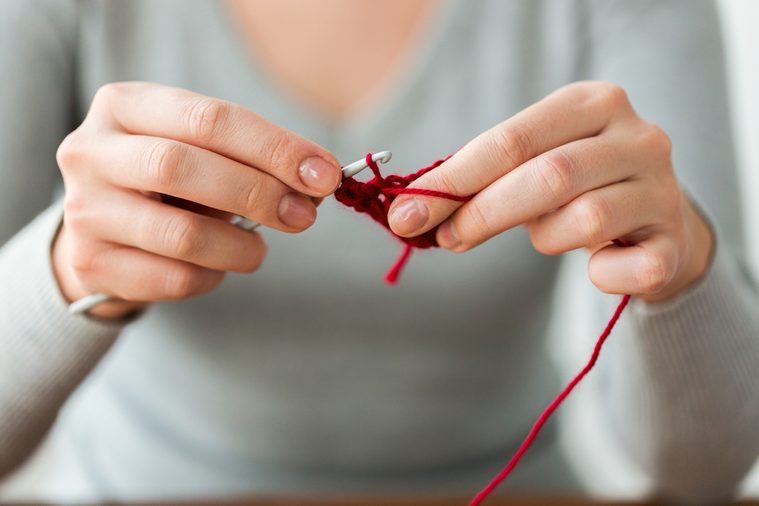
Do an act of kindness
Candace Payne went viral for her infectious laughter when she put on a Chewbacca mask and the Internet hailed her “Chewbacca Mom” after falling in love with her joy. She went on to write Laugh It Up: Embrace Freedom and Experience Defiant Joy. In an email, she told Reader’s Digest, “One of my favorite simple joys is to ‘create’ for others. I think about making something fun/pretty/useful to give away and I get to it. It might be crocheting a hat for a friend, lettering my favorite fun quote in sparkly markers, putting together a grocery bag of goodies and a taco recipe to drop on the doorstep of a neighbor, or causing an unexpected Nerf battle with the hubs after the kids fall asleep. When I do for others, I feel my mood instantly changes. My focus shifts from my problems and helps me find a way to brighten someone else’s day.” Inspired by Candace? Don’t miss 24 stories about the kindness of strangers that’ll make you tear up.

Take a morning bath
Nighttime baths are revered for their ability to reduce stress, but Marie Virella, a New Jersey resident, found that a morning bath helps her start her day on the right foot. Two to three times per week, before work she takes a 15 to 30-minute bath with sea salt, oil (coconut or olive), and lavender essential oil. “It makes me pause even it’s only for a few moments to be alone with my thoughts. I also know that when I do it in the morning I know that I am making my health a priority and making time take care of myself,” she says. (Try one of these bath bomb recipes when you need me-time.)
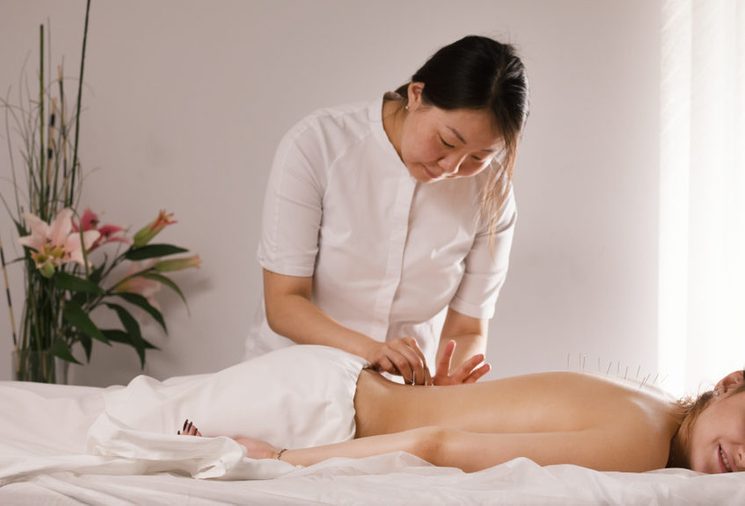
Try acupuncture
After Jessica Galletta, a Philadelphia-based yoga teacher, read about acupuncture as an alternative to an antidepressant, she gave it a try and found that regular sessions, over time, improved her mood. “I’ve noticed that I always leave with my mood feeling more balanced. I feel calm and more in control of my thoughts. My mind is less clouded.” (These products that make you feel happier will also clear your head.)

Make an empowering playlist
Music is scientifically proven to improve focus and lower anxiety among many other health benefits. Molly Gallagher, an actor, writer, and teaching artist in New York, created a Spotify playlist called “Go Molly Go” to power her through her unpredictable life as a freelance artist. Her playlist includes favorites like “Girl is on Fire” by Alicia Keys and “Rise Up” by Andra Day. “I do a lot of writing at my desk in my apartment—submitting for jobs, writing scripts, grant applications, lesson plans—the constant hustle can feel mundane especially if you aren’t seeing the results you want to manifest,” Gallagher says. “I think the playlist reminds me to enjoy the process on a daily basis.” (What is happiness? Learn what the science says.)

Surprise someone in need
Molly Butts, a health and physical education teacher in Vermont, often gets her family or a group of students together to make “blessing bags,” (bags filled with essentials such as Kleenex, hand warmers, gloves, granola bars, etc.) for people in need. “One time we gave a bag to a man and his eyes got so big. As we were walking away he opened the bag, took out the toothbrush, started doing a happy dance and kissed the toothbrush,” she shares. “This was incredibly uplifting because we were able to make someone’s life a little bit easier (and bring him joy), with just a toothbrush.”

Keep a file of uplifting notes
In the email inbox of Aviva Patz, RD.com’s deputy editor, there is a file she keeps for posterity. She says, “I keep messages that make me happy. If I feel blue, I open the file and read the drama teacher’s emails about my daughter’s star performance or my colleague’s message about how much she loves working with me.” Research shows that affirmation boosts self-efficacy so reminding ourselves of kind words we’ve received is bound to provide a boost. Here’s how to give a compliment that sticks.

Wear fuzzy socks
Joy Johnson, a licensed clinical social worker in Georgia has a simple way to feel toasty: wear fuzzy socks. Bonus points if you have fuzzy and funky. “It’s a fun, silly thing that can be your secret for the day, a fun conversation starter when someone sees the socks, or an extra way of showing yourself care when you’re at home. No extra planning or money needed.” You can pair them with these cozy loungewear sets you’ll definitely want to live in.

Take a photo
Amanda Stemen, a licensed social worker in California, explains that activities that lead to surges in happiness often have to do with mindfulness. To that end, she knows a photographer who reported feeling happier after spending time taking pictures. “When you’re doing something you enjoy, you’re more easily in the present moment,” she explains. “In the present moment, there is peace and ease when you aren’t worrying about the past or future.”

Crack a smile…
…even if you really don’t feel like it. Simply pulling the sides of your mouth into a grin impacts your mood quickly, in a couple different ways, says David Ludden, PhD, a professor of psychology at Georgia Gwinnett College and author of The Psychology of Language: An Integrated Approach. “The first way is what’s called facial feedback. As your brain detects that your ‘grin’ muscles are engaged, it seems to think to itself: ‘I’m smiling so I must be happy.’ The second way is through social feedback. Emotions are contagious, and as your colleagues respond positively to your ‘faked’ cheerful mood, you starting feeling better as well.” Here are even more science-backed reasons to smile ASAP.

Grab a bouquet of flowers
There’s a good reason we send flowers when someone is in the hospital or to show people we care on their birthdays: The blooms really do make people happy! A 2018 study by researchers at the University of North Florida found that women reported less stress and more happiness after having fresh flowers in their houses for several days. An older, smaller study, done by Harvard evolutionary psychologist and TED-talker Nancy Etcoff, PhD, had similar results. People who were given a bouquet of flowers and kept them on display for a few days felt more relaxed and experienced less anxiety and depression. Most large grocery stores sell fresh flowers these days, often for as little as $5—so next time you’re feeling blah, why not pick up a bouquet?

Step outside
You don’t have to spend an hour forest bathing to get the happiness-boosting benefits of Mother Nature. Just five minutes of “green exercise”—moving your body outdoors in the presence of trees or other natural scenery—can improve mood and self-esteem, according to a 2010 review of research published in the journal Environmental Science and Technology. The positive effects were even greater when water was around; no wonder a lakeside stroll is so refreshing!

Tie up a loose end
Taking care of some undone task that’s been hanging over your head can soothe difficult emotions and boost your mood, according to psychologist Alice Boyes, PhD, author of The Anxiety Toolkit. Loose ends create a sense of disarray and as they pile up, they become demoralizing. “Addressing a problem that has been hanging around forever can help you feel more in control and confident,” writes Boyes. “Identify a task you started, but didn’t finish, one which could be completed in less than 30 minutes—ideally, less than 15,” then handle it. Ah, near-instant relief. Here are more instant mood boosts you’ll want to make a habit of doing.

Try progressive muscle relaxation
Stress and anxiety create tension in your muscles. One way to break that tension and improve your mood quickly is a strategy called progressive muscle relaxation, say the experts at the University of Michigan Health System. The way it works: Simply tense one group of muscles—such as those in your face or hands—as you inhale, then relax them as you exhale. Then move on to the next group. The exercise works best when done in a particular order, so get more details at the University of Michigan website or search for free “progressive muscle relaxation audio or videos” online.
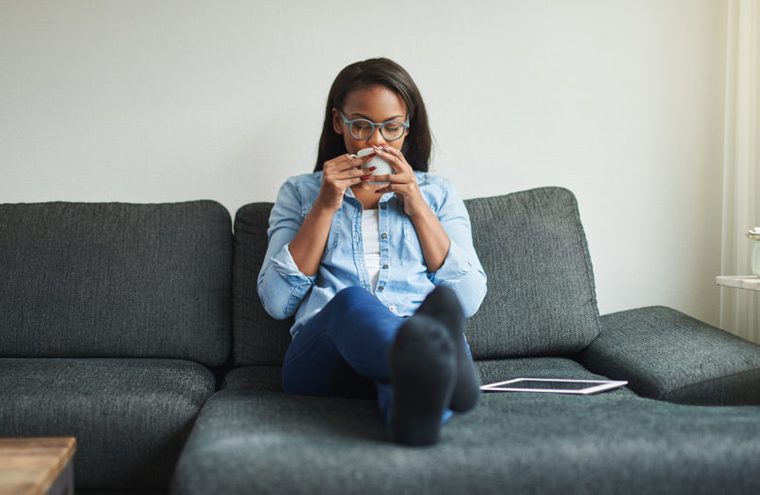
Take a coffee break
For coffee-lovers, sometimes all it takes to feel instantly better is walking in the door of a café, and getting hit in the face by that warm scent of java. It’s not just the pleasurable smell and taste of coffee that makes folks feel good—caffeine is a powerful mood-booster. A study of more than 50,000 women by researchers at the Harvard School of Public Health found that caffeine acts as a mild antidepressant by increasing production of feel-good brain chemicals such as serotonin and dopamine.

Bake some cookies
…or just light a vanilla-scented candle: The fragrance of vanilla may trigger the release of feel-good endorphins in the brain. One study at the Memorial Sloan-Kettering Cancer Center found that a sweet, vanilla scent lowered patients’ anxiety while undergoing MRI scans. In research published in the journal Chemical Senses in 2005, study subjects reported feeling happy and relaxed after smelling vanilla. Easy ways to keep vanilla handy when you need it: Stress-relief candles that contain the fragrance, vanilla-scented hand lotion, and essential oils to diffuse the scent into any room. Check out some 10 other natural ways to get an endorphin rush.

Let it go
Sometimes struggling against a difficult emotion or blue mood makes it feel even worse. “Telling yourself that a certain emotion is intolerable or dangerous traps you,” writes Noam Shpancer, PhD, a professor of psychology at Otterbein University in Ohio. “You become hyper-vigilant about any possibility of this feeling arising.” Accepting the reality of your feelings, while not diving into and wallowing in them does the opposite—and it’s a key tenet of a type of psychotherapy called Acceptance and Commitment Therapy. “Acceptance is implicitly akin to saying, ‘This is not that bad.’ Which is the truth—negative emotions may not be fun, but they won’t kill you,” says Dr. Shpancer. “Experiencing them as they are is eventually much less of a drag than the ongoing (failing) attempt to avoid them.” These are the 10 things optimistic people do every day.
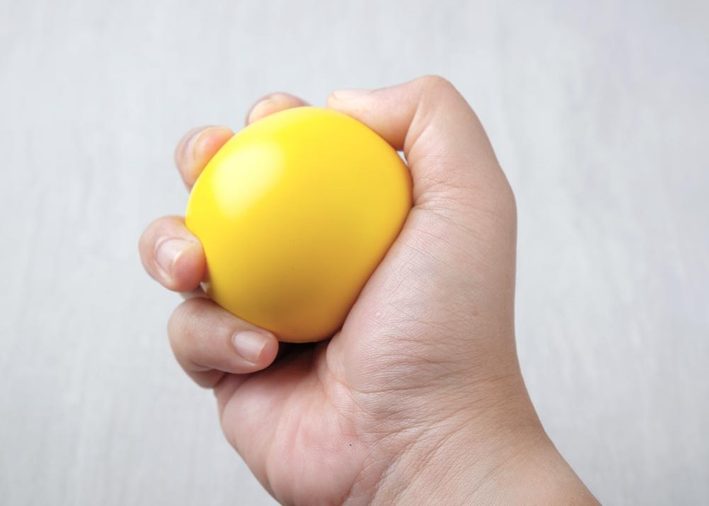
Make a stress ball
Tammie Rosenbloom, a Minneapolis-based licensed social worker who owns Walk Talk Therapy LLC, has found that some of her clients are tactile and like to use sensations as a way to calm themselves. So she has them make stress balls by placing rice and essential oils like lavender (a proven stress-reliever) into a balloon. “The action of squeezing a stress ball gives people a way to expel nervous energy. Others report it improves their concentration,” she tells Reader’s Digest. Here are 37 more tips for easing stress.

Touch and be touched
A quick hug, or even some friendly shoulder-patting sets off a cascade of reactions in the body that lead to a calmer, happier state of mind. Not only does a supportive touch lower blood pressure and slows down your heart rate, it just plain feels good, Matt Hertenstein, Ph.D., chair of the psychology department at DePauw University in Indiana told NPR. “A soft touch on the arm makes the orbital frontal cortex light up,” the same area of the brain that reacts to good aromas and sugary foods, Dr. Hertenstein said. “So, touch is a very powerful rewarding stimulus—just like your chocolate that you find in your cupboard at home.”

Sniff something pepperminty
Research suggests that breathing in the scent of peppermint can lower blood levels of the stress hormone cortisol. Other studies show that sniffing the minty stuff can increase energy levels and allow exercisers to work out longer and harder. One way to get more mint in your life: Put one drop of essential peppermint oil onto a cotton pad, hold it under your nose and breathe normally for a minute or two. Find out 9 other essential oils that are instant pick-me-ups.

Switch off your phone…
…and computer, smartwatch, and tablet. Numerous mental health experts have warned us of the negative effects of being too “plugged in”—and studies back them up. One 2017 study published in the Depression and Anxiety journal found that adults who use social media frequently are 2.7 times more likely to be depressed than those who don’t. “The latest research demonstratively shows that excessive Internetting, smart phoning, and social media make us miserable,” Blake Snow, author of Log Off: How to Stay Connected after Disconnecting, told Best Life. “Bottomless Internetting causes dopamine loops, which keeps us searching and searching instead of creating and connecting with meaningful things. When I’m feeling down, I always refresh my offline endeavors…This has rarely failed me.”
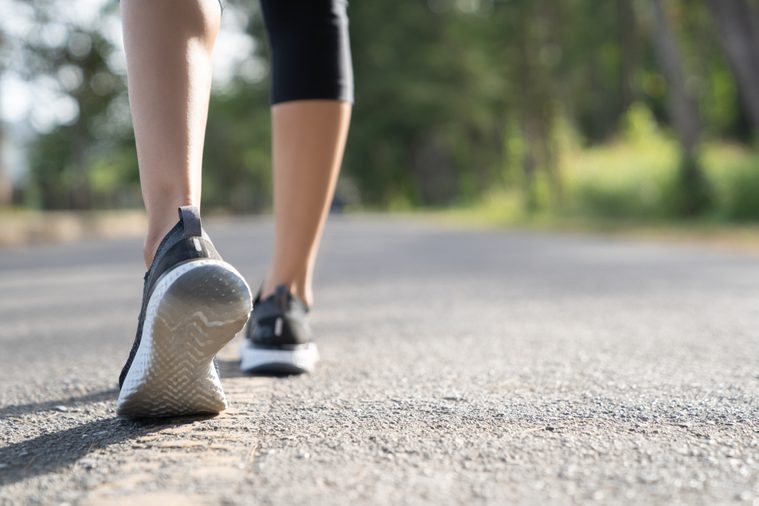
Run around the block
One of the quickest ways to get the happy juices flowing in your brain is to move your body. Exercise—even just a little bit—increases heart rate, boosts energy, reduces tension, and can trigger the release of endorphins in the brain. “I tell all my clients if you can do a quick ten squats where ever you are; at your desk, at Starbucks waiting in line, or even in Target while you’re shopping—it will release dopamine and serotonin directly to your brain and you will instantly feel happier and be in a better mood,” therapist Cali Estes, PhD., told Best Life. “I find it to be the quickest, cheapest, and most effective way to get that serotonin dopamine boost naturally.”

Put on something yellow
Color psychologists, fashion designers, artists, and interior decorators know that colors have a “feeling”—some are cozy, others are exciting or cheerful. Although hard data is sparse and sometimes contradictory, a group of researchers at the University of Manchester in the United Kingdom have created a way to visually determine patients’ pain levels and moods—the “Manchester Color Wheel.” In their studies using the Wheel, yellow was the color most frequently linked to a normal mood (as opposed to gray, which was linked with anxiety and depression). The color “almost always creates a positive reaction,” Dr. Mehmet Oz, MD, has said on his TV show—not only do people naturally associate the color with optimism, but the color also activates two color-sensing “cone” cells in our eyes at the same time, so it really grabs our attention. Discover 10 other ways to be happier without really trying.

Plan to watch a funny video
Researchers at Loma Linda University have been studying laughter for decades. They’ve confirmed, over and over again, that laughing at something you find truly funny boosts levels of healthful hormones in the body and improves mood. What’s more surprising? Even anticipating a future funny moment—such as planning to watch a comedy show or cartoon—can slash levels of stress hormones. One 2008 study found that looking forward to a funny moment cut levels of cortisol, epinephrine, and other brain chemicals associated with stress by up to 70 percent.

If you have time, take a quick nap
A brief nap can boost your mood, energy level, and ability to concentrate, according to the National Sleep Foundation (NSF). Although napping won’t help you make up for long-term sleep deprivation, a short 20- to 30-minute rest in the afternoon will provide a significant boost without interfering with your ability to fall asleep later that night.

Do the opposite of what you feel like doing
When you’re down, the thing you most want to do may not be what’s best for you, says licensed clinical social worker Jennifer Rollin, MSW, an eating disorder therapist and founder of The Eating Disorder Center in Rockville, Maryland. For example, depression may make someone want to “hide out” from others and be alone, or anxiety may trigger an urge to emotionally overeat in someone with disordered eating. “These urges come from a good place, as the individual is often trying to ‘feel better,” writes Rollin. “However, in the long-run, they only serve to make the person feel even worse.”
If you know deep down that the thing you want to do is probably going to make things worse, try a skill borrowed from Dialectical Behavior Therapy called “opposite action.” If you want to keep something a secret because you’re ashamed, share it with someone trustworthy, for example. If you want to freak out and scream in anger, talk calmly and slowly. If you want to isolate, actively seek out company.

Donate to a good cause
If you’ve ever spent an afternoon volunteering or swooped in to help a friend out of a tough spot, you already know how good that feels. One 2006 study by Jorge Moll at the National Institutes of Health found that giving money to charity lights up areas of the brain associated with pleasure and social connection. And researchers at Harvard Business School found in a 2008 study that gifting money to someone else made them happier than buying something for themselves. Researcher’s call it the “helper’s high”—tap into it the next time you need an emotional lift.

Write about a good memory
Memory is a powerful thing. Instead of using yours to remember times when you were down or anxious like you may be right now, think about an intensely positive experience instead. Got one ready? Sit down and write about it for 20 minutes. A groundbreaking study by psychologists at Southern Methodist University found that people who did such “positive writing” for 20 minutes three days in a row not only felt better right away, but the improvements in mood lasted for months. Next, read on for 50 more ways to boost your happiness.

